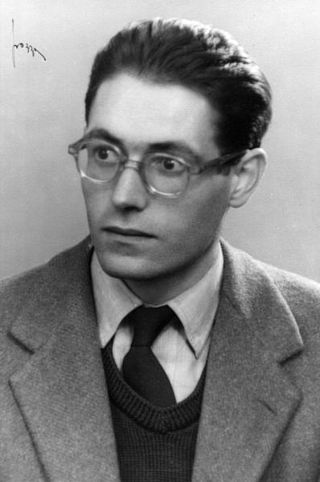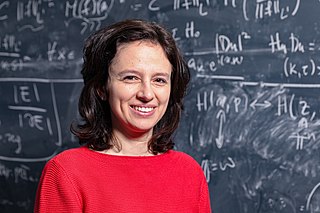
The Scuola Normale Superiore in Pisa is a public university in Pisa and Florence, Tuscany, Italy, currently attended by about 600 undergraduate and postgraduate (PhD) students.

Ennio De Giorgi, a member of the House of Giorgi, was an Italian mathematician who worked on partial differential equations and the foundations of mathematics.

Mario Pieri was an Italian mathematician who is known for his work on foundations of geometry.

Guido Stampacchia was an Italian mathematician, known for his work on the theory of variational inequalities, the calculus of variation and the theory of elliptic partial differential equations.

Beppo Levi was an Italian mathematician. He published high-level academic articles and books, not only on mathematics, but also on physics, history, philosophy, and pedagogy. Levi was a member of the Bologna Academy of Sciences and of the Accademia dei Lincei.
The Stampacchia Gold Medal is an international prize awarded every three years by the Italian Mathematical Union together with the Ettore Majorana Foundation (Erice), in recognition of outstanding contributions to the field of Calculus of Variations and related applications. The medal, named after the Italian mathematician Guido Stampacchia, goes to a mathematician whose age does not exceed 35.
The Caccioppoli Prize is awarded by the Italian Mathematical Union to an Italian mathematician not exceeding the age of 38 who established a wide international reputation. The prize is entitled to the memory of the Italian mathematician Renato Caccioppoli and is awarded on the occasion of the Italian Mathematical Union conference every four years. In its early stages the prize was awarded every two years. The recipient currently receives 10,000 euros.

Luigi Ambrosio is a professor at Scuola Normale Superiore in Pisa, Italy. His main fields of research are the calculus of variations and geometric measure theory.

Enrico Giusti, is an Italian mathematician mainly known for his contributions to the fields of calculus of variations, regularity theory of partial differential equations, minimal surfaces and history of mathematics. He has been professor of mathematics at the Università di Firenze; he also taught and conducted research at the Australian National University at Canberra, at the Stanford University and at the University of California, Berkeley. After retirement, he devoted himself to the managing of the "Giardino di Archimede", a museum entirely dedicated to mathematics and its applications. Giusti is also the editor-in-chief of the international journal, dedicated to the history of mathematics "Bollettino di storia delle scienze matematiche".

Aldo Andreotti was an Italian mathematician who worked on algebraic geometry, on the theory of functions of several complex variables and on partial differential operators. Notably he proved the Andreotti–Frankel theorem, the Andreotti–Grauert theorem, the Andreotti–Vesentini theorem and introduced, jointly with François Norguet, the Andreotti–Norguet integral representation for functions of several complex variables.

Guido Ascoli was an Italian mathematician, known for his contributions to the theory of partial differential equations, and for his works on the teaching of mathematics in secondary high schools.
Mariano Giaquinta, is an Italian mathematician mainly known for his contributions to the fields of calculus of variations and regularity theory of partial differential equation. He is currently professor of Mathematics at the Scuola Normale Superiore di Pisa and he is the director of De Giorgi center at Pisa.
Federico Cafiero was an Italian mathematician known for his contributions in real analysis, measure and integration theory, and in the theory of ordinary differential equations. In particular, generalizing the Vitali convergence theorem, the Fichera convergence theorem and previous results of Vladimir Mikhailovich Dubrovskii, he proved a necessary and sufficient condition for the passage to the limit under the sign of integral: this result is, in some sense, definitive. In the field of ordinary differential equations, he studied existence and uniqueness problems under very general hypotheses for the left member of the given first order equation, developing an important approximation method and proving a fundamental uniqueness theorem.
Sergio Campanato was an Italian mathematician who studied the theory of regularity for elliptic and parabolic partial differential equations.

Giovanni Alberti is an Italian mathematician who is active in the fields of calculus of variations, real analysis and geometric measure theory.

Alessandro Faedo was an Italian mathematician and politician, born in Chiampo. He is known for his work in numerical analysis, leading to the Faedo–Galerkin method: he was one of the pupils of Leonida Tonelli and, after his death, he succeeded him on the chair of mathematical analysis at the University of Pisa, becoming dean of the faculty of sciences and then rector and exerting a strong positive influence on the development of the university.

Andrea Braides is an Italian mathematician, specializing in the calculus of variations. He is a professor at the University of Rome Tor Vergata and at the International School for Advanced Studies (SISSA) in Triest.
Roberto Conti was an Italian mathematician, who contributed to the theory of ordinary differential equations and the development of the comparison method.
Marco Abate is an Italian mathematician.

Maria Colombo is an Italian mathematician specializing in mathematical analysis. She is a professor at the EPFL in Switzerland, where she holds the chair for mathematical analysis, calculus of variations and partial differential equations.











